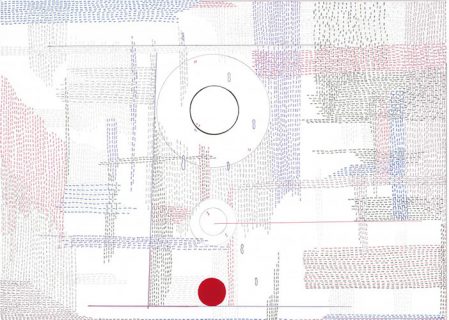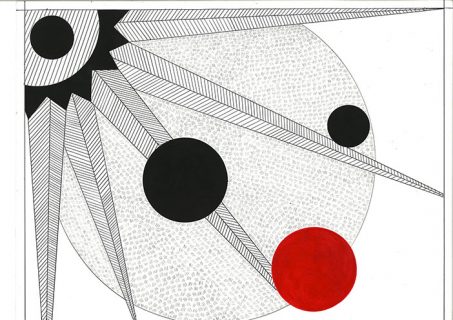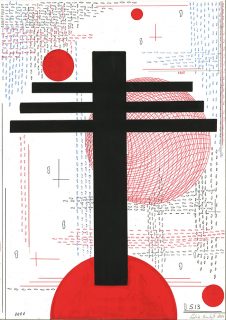Some of the works of art captivate the attention at first glance; they can be found extremely influential, pleasurable, energetically charged and charging. We can look at and experience them without any need to know the prehistory or who made it. However, knowing these facts might provide a different perspective and a kind of in-depth look. In some instances, the concept and the story of an artist become the core of the art work.
After Duchamp with his Readymades opened the doors to all contemporary artists, a container of yogurt could literally be considered a piece of art. And when it is unclear if artwork such as this example of a container is only a clever trick which later will be circulating in the art market, the story can also serve as a glimmering lodestar for those who still believe in art as a matter of genuineness and ingenuity.
To the latter Secret 13 is presenting the interview with Gedvile Bunikyte and the story about her genuine creative impulses.
Thanks to Aristotle we have plenty of quotes to recite. One such quote is about our natural desire to apply our reasoning, or as he said “ALL men by nature desire to know.” [1] Gedvile, also known by her artist name Grace B, is one of those thirsty for knowledge and cognition, who devoted her life to crack the code of logos, nature and being. She builds her knowledge in philosophy, physics, psychology, spirituality, and mysticism. The way she expresses her reasoning is wordless, symbolic and abstract, as she has created her own language in drawings – language which is similar to that of Aristotle’s only because it is presented on a piece of paper by using writing utensils.
Her works are minimalistic and yet astonishing due to the abstraction and conceptualisation that, if to put into a words, would be hard to understand but possible for most people to feel. Brilliant Tolstoy’s observation, "an artist is a man who can draw and paint everything." [2] Notwithstanding that, it is possible to catch the notion of her work, you can see light symbols of nature here and there, and the titles speak for themselves too. Still her work is not in any way constricting or veiled in obstacles, but rather it empowers the imagination and intellect of spectators.
Grace B gained her university degree in Goldsmiths University in London. At the time she had the possibility to experiment with different art mediums, including painting, performance and photography. But the technique she chose and her current stylistic approach crystallised after a long time of learning, contemplating and working. After almost ten years of a process of maturing, clarifying and manifesting her own ideas, she turned to the most simple tools and forms to achieve the most powerful results.
Lately she has been been travelling from one city to another. Her works now adorn the exhibition halls from London to Vienna and Vilnius. And as more time passes, the more people are captivated by these sincere drops of artistic energy that float in the vast ocean of what we call the art industry, the art world, or simply the world.
Interview:
Could you share your favourite Secret 13 mix, if you have one, which our readers could listen while reading the interview.
There are so many! I am a big fan of Secret 13 and the work that is published on this platform. I have so much respect for all the artists. Too many to mention! If I had to choose one, it would be Rrose perhaps. The mix is incredible, so strong and delicate at the same time. A great mix to read the interview or travel in space.
You have a distinguishable artistic style, could you tell us, how did it turned to what it is now?
I was never into drawing much, but since I was a child I have been looking for a way to communicate. For a long time there was this big gap between what I knew and felt and who I was.
I was a very sensitive child and I was trying to fight it for a long time. It created a conflict inside me, that was a very painful experience. It took me awhile to understand that I am not here to suffer and let all of that go. With that came peace and clarity. I started trusting, and accepted that if all I have are lines and circles, I have to be grateful for it and it is more than enough for my journey on this planet. So I said thank you and what came after was a very beautiful experience. Things started to flow, I became a part of that movement. I never set out to invent anything, or start a new style, or be the best at anything in particular. All along I wanted a means of communication and to help myself heal. So I found that what I do now is the best way to achieve both.
We are all vulnerable and that is the beauty and humanity’s greatest strength. I make pictures to honour that and to help myself remember what really matters. That is my language, my rhythm, my music and it is very personal, but I think that is also the reason why so many others can relate to it.
What is the process of creation? Do you do pre-sketches or you let your hands to do the job without prior considerations of what result you want to achieve?
I do not draw to get a specific result, but I draw with a specific intention. I work slowly and without goals, that is when I am most productive and creative. I just follow what is happening and try not to judge it. I try to leave myself out of it. If I notice that a desire to control or dominate arises, I stop working and do something else that is pleasant instead. For me, as an artist, the most important thing is energy, that is what I care about the most. I am particular and specific about my contribution in this way, and try not to contribute to things that I do not want to see. Attention is really a super-power one should use it wisely. I focus on general feeling, and pictures just come.
What role does colour play in your drawings?
I only use red, blue and black, with small additions of silver. The energy of these colours is the most helpful to what I try to accomplish. It contains a vibration that helps to communicate that and symbolically they represent the concepts I am most interested in right now.
What other art forms you like to use beside drawing?
I have experimented with many, but I found that making lines on paper was the most precise, direct and clear way for me to express myself.
Do you think that the university training has affected your work?
Not directly. But it certainly opened me more to who I was and who I wanted to be. I was very blessed to go to the university where that was encouraged, it opened new perspectives and it did not take away the freedom to express myself in my own way. It took me some years after I graduated to arrive to what I do now, but I am glad I took my time, and that I was strong enough along the way to leave things behind that were not the right match for me.
Would you agree that nowadays connections and advertisement are more important for an artist in order to be known than his capability to create something valuable? By valuable I mean that a work of art is genuine and sincere creation of an artist, rather than an attempt to make a falsification of the very well know artists.
That is one way of looking at it. But I do not think it is helpful.
We all have so much inside of us and we have the internet! Once you understand that, you know that the only connection you need is to yourself and the only advertisement you need is to share what you have with the person next to you. I think the most important thing is to live authentically to your own potential, based on your own truth. How others do things and to what outcome, does not concern me. I can only hope to do my best from where I am at.
You mention philosophy as a source of inspiration, would you say that your drawings is a kind of symbolical language to present your understanding of reality, or it is just a sheer art of abstraction? In other words, would you say that your works are more realism than abstraction or vice versa?
That is a very good question. I certainly see them as a symbolic language and to me it is realism. It is true that I do not draw objects from the physical reality, but the unseen is no less real. So to me it is definitely an expression of reality. I draw with a respect to the bigger picture, or more precisely, what is outside of the picture. What we see is already the end result that is not reality to me, the truth is deeper.
Could you contemplate a little bit on Contemporary Art, how would you define it?
Definitions can be helpful, but I think that sometimes you have to make your own. I have my own classifications and methods when it comes to art theory. I define art to myself in what I call ‘vibe groups’ that is the only system that I know that works for me. It might not seem serious to some, but it is helpful to me. Whether it is Contemporary or not I rarely contemplate. I like art that deals with subjects outside of what we know as time. Whether it is a cave painting, or latest pieces by my contemporaries, I classify them all by ‘vibes’, the energy of the work interests me the most.
In one of our mixes you are reading Lithuanian poetry! How important is music in your life and when you are creating something?
It is very important. Music is the most intelligent way humans can express themselves. In a way I see my work as music too. I work on a piece until it ‘sounds’. It does not manifest in audio waves but it has a resonance, rhythm, vibration, so I classify it as music.
RRR (Racehorses Are Resources) is a great project. I know Chris for over a decade now, he is a talented musician and is passionate about art. It was an honour to contribute to the project with my poem. I look forward to hear what they will do next. I also share a studio with a musician, so music is an integral part of my day. Music really is the essence of life, or as Plato said, “music gives a soul to the universe, wings to the mind, flight to the imagination and life to everything.”
What artists do you most admire?
I admire artists who speak their own truth. Who share their wisdom and teach those around them love, freedom and connection to spirit. Throughout my life many artists have touched me in one way or another. Some of the artists that I particularly feel love and deep gratitude to are A. Martin, M.K.Ciurlionis, Cy Twombly, K. Malevich, W. Laib.
Current and upcoming exhibitions, please...
I am extremely grateful for the opportunities and the people that have been kind and supportive. It has been a very exciting year so far and some great shows are coming up in Vilnius, London and Vienna. All the details of the shows are on my website. It would be great to see you there!
1. Aristotle Metaphysics
2. Leo Tolstoy What Is Art?






2 Comments
Pingback: SECRET THIRTEEN INTERVIEW – GEDVILE BUNIKYTE «
What a beautiful interview with an artist Grace B.! Such positive vibes! thank you!